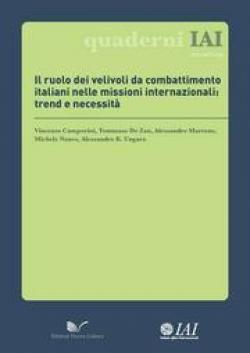Il ruolo dei velivoli da combattimento italiani nelle missioni internazionali: trend e necessità
Italian combat aircraft have played an increasing important role in the international missions in which Italy has participated in the post-Cold War era - from the First Gulf War to Libya, including Bosnia-Herzegovina, Kosovo and Afghanistan. This participation has been a significant tool of Italy's defense policy, and therefore of its foreign policy towards crisis areas relevant to its national interests (from the Western Balkans to the Mediterranean), as well as towards its most important allies within NATO and the EU. This IAI publication analyses the role of these military capabilities in recent operations and their prospects for the future. In fact, a number of trends can be inferred from the operational experience in ten international missions, in which Italy deployed more than 100 combat aircraft in more than 13,000 sorties, clocking up 36,000 flight hours. These trends are considered in light of the recent developments in the doctrine of Air Power, as well as possible future scenarios for the use of combat aircraft in crisis theaters. The aim of the analysis is to understand the needs of the Italian Armed Forces - the Air Force and Navy in particular - which will have to replace a substantial portion of their current combat fleets in the near future due to the gradual obsolescence of the aircraft in service - an operational necessity linked to the inevitable political decisions regarding the options available in the field of military procurement for maintaining the capabilities required so far for international missions. In this context, the study looks into the acquisition of F-35 aircraft, also considering the industrial aspects of a multinational program that will produce more than 3,000 units for over 12 countries.
Report prepared within the framework of the research "Fighter aircraft’ role in crisis management operations: Italy’s trends and needs", presented at the conference on "La componente aerea nelle missioni internazionali dell'Italia: trend e scenari", Rome, 13 May 2014.
English version: IAI Research Paper 16.
-
Details
Roma, Nuova Cultura, March 2014, 142 p. -
In:
-
Issue
10 -
ISBN/ISSN/DOI:
978-88-6812-296-6
Ringraziamenti, p. 7
Executive Summary, p. 9.-22
Prefazione, p. 23-25
Lista degli acronimi, p. 27-28
1. La partecipazione italiana alle missioni internazionali: il ruolo dei velivoli da combattimento, p. 29-60
1.1 Iraq (1990-1991)
1.2 Bosnia-Erzegovina (1993-1998)
1.3 Kosovo (1999)
1.4 Afghanistan (2001-2014)
1.5 Libia (2011)
1.6 Il ruolo dei velivoli da combattimento italiani nelle missioni internazionali
2. Operazioni aeree attuali e future: la dottrina e le tendenze, p. 61-67
2.1 Il Potere Aereo: i fondamenti della dottrina
2.2 Trend derivanti dalla recente esperienza operativa
3. Scenari di possibili operazioni aeree future, p. 69-82
3.1 Creare e mantenere una No-Fly-Zone: scenario "Protezione dei Turiani"
3.1.1 Il contesto strategico
3.1.2 Obiettivi della missione
3.1.3 Fattori critici del teatro operativo
3.1.4 Capacità nemiche e corso d'azione
3.1.5 Componente aerea del corso d’azione alleato e capacità necessarie
3.2 Supporto aereo a operazioni di terra: scenario "Stabilità in Banon"
3.2.1 Il contesto strategico
3.2.2 Obiettivi della missione
3.2.3 Fattori critici del teatro operativo
3.2.4 Capacità nemiche e corso d'azione
3.2.5 Componente aerea del corso d'azione alleato e capacità necessarie
4. Le necessità delle Forze Armate italiane e il programma F-35, p. 83-110
4.1 Prima domanda: la partecipazione italiana alle missioni internazionali tutela gli interessi nazionali?
4.2 Seconda domanda: di quali capacità aeree ha bisogno l'Italia per partecipare alle missioni internazionali?
4.3 Terza domanda: quali opzioni di procurement sono disponibili per acquisire questo tipo di capacità?
4.4 Quarta domanda: è meglio acquistare F-35 "chiavi in mano" oppure partecipare al programma multinazionale di procurement?
5. L'Italia e il programma F-35: la prospettiva industriale, p. 111-123
5.1 L'approccio del best value for money
5.2 La partecipazione italiana al programma F-35
Conclusioni, p. 125-126
Bibliografia, p. 127-139
Allegato I - Lista degli intervistati, p. 141-142
Topic
Tag
Related content
-
Publication30/12/2014
The Role of Italian Fighter Aircraft in Crisis Management Operations
leggi tutto -
Event25/07/2014
La componente aerea nelle missioni internazionali dell’Italia: trend e scenari
leggi tutto -
Ricerca21/01/2014
Fighter aircraft’ role in crisis management operations: Italy’s trends and needs
leggi tutto



